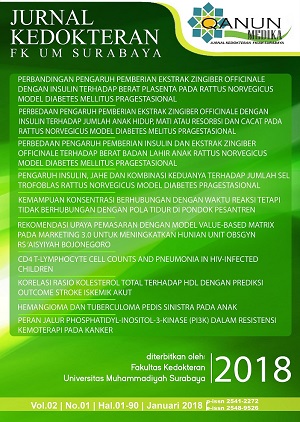Perbandingan Pengaruh Pemberian Ekstrak Zingiber officinale dengan Insulin terhadap Berat Plasenta pada Rattus norvegicus Model Diabetes Mellitus Pragestasional
Abstract
Diabetes mellitus is a chronic disease that occurs in the community, with 1.9% prevalence of in the world is and the seventh leading cause of death in the world. It is estimated to increase up to 21.3 million by 2030 if the pattern of Diabetes management is not well developed. In 2007, the prevalence of Pregestational Diabetes Mellitus in Indonesia was 12% and had an impact on placental development that was important during pregnancy for fetal survival with placental weight as the indicator. Diabetes Mellitus pregestational therapy is insulin, however, it often causes complications. Oral hyperglycemic drugs with ginger dose extract of 500mg/kgBW significantly decreased serum glucose levels in diabetic-induced rats. Ginger extract is expected to decrease blood glucose levels so as to increase the weight of placenta. The purpose of this study was to determine the effect of insulin and ginger extract on the weight of placenta Rattus norvegicus model of diabetes mellitus. This research is an experimental research using post test only control group design. The population used in this study was pregnant Rattus norvegicus with simple random sampling. The independent variables are insulin and ginger extract and the dependent variable is the weight of placenta. Data analysis for placental weight using Kruskal Wallis was continued by Post Hoc Bonferroni test. Test results for placental weight p>α (0.63 > 0.05) mean that there is no difference in placental weight between negative control, positive control, and treatment group. The conclusion of this study is there is no significant difference between groups, however, based on mean data the weight of placenta Rattus norvegicus model of diabetes mellitus with insulin and ginger extract therapy are higher than the control group
Full text article
References
ADA (2016). Standarts of medical care in diabetes. American Diabetes Asssociation. 39, pp1-112
Cunningham FG, Leveno KJ, Bloom S.L, Hauth, J.C., Rouse , D.J. and Spong C.Y,. (2012). Plasenta dan membran janin. Dalam: (terjemahan) Hartono H dkk (editor). Obstetri Williams. Edisi ke-23. Vol 1. Jakarta: EGC.
Cunningham FG, Leveno KJ, Bloom S.L, Hauth, J.C., Rouse , D.J. and Spong C.Y, (2014). William Obstetri (24 rd ed.). New York, USA: McGraw-Hill
Hermanto TJ, Pranoto A (2004). Konsensus pedoman diagnosis dan terapi diabetes mellitus dalam kehamilan.
Hermanto TJ (2014). Kehamilan dengan diabetes mellitus dalam ilustrasi pragestasional dan gestasional. Surabaya: Global persada press.
Departemen Kesehatan Republik Indonesia (2008). Pedoman teknis penemuan dan tatalaksana penyakit diabetes mellitus. Jakarta: Departemen Kesehatan Republik Indonesia.
Catalano P (2002). The diabetogenic state of maternal metabolism in pregnancy. NeoReviews Vol.3 No.9 e165
Cots DS, Rolando A, Mugnaini MT (2013). Determination of cell proliferation and apoptosis in plasentas of chronically stress rats. Open Acces Scientific Report Volume 2. Issue 3.
Yamauchi H., Katayama K., Ueno M., (2007). Essential role of p53 in trophoblastik apoptosis induce in the developing rodent placenta by treatment with a dna-damaging agent. Spinger Science. Apoptosis. Vol.12:1743-1754.
Heinonen S, Taipale P, Saarikoski S. (2001). Weights of placentae from small for gestational age infants revisited. Placenta. May; 22(5):399-404.
Baptiste-Roberts K, Salafia CM, Nicholson WK, Duggan A, Wang NY, Brancati FL (2008). Maternal risk factors for abnormal placental growth. The National Collaborative Perinatal Project. BioMed Central Pregnancy and Childbirth. 2008 : 8-44.
Magee MS, Walden CE (2014). Diabetes gestasional. JAMA 2: 609.
Huppertz, B., Hunt, J.S (2000). Trophoblast apoptosis and placental development-a workshop report. Placenta; 21,S74-S76.
ACOG (2005). Practice bulletin No. 60. Pregestasional diabetes mellitus’. ObsterGynecol;105(3) 675-85
Li Y, Tran VH, Duke CC, Roufgalis BD (2012). Preventive and protective properties of zingiber officinale (ginger) in diabetes mellitus, diabetic complications, and associated lipid and other metabolic disorder A Brief Review. Hindawi publishin corporation Evidence Based Complementary and Alternative Medicine Volume 2012, Article ID 516870, 10 pages doi:1115/2012/516870 Maclntos, MC., 2006. Perinatal mortality and congenital anomalie in babies of women with type1 or type 2 duiabetes in England, Wales, and Notherrn Ireland: population based study. BMJ 333:177.
Al-Amin, ZM., Thomson , M. Al Qattan, K., Peltonen-Shalaby, R. And Ali, M. (2006). Anti diabetic and hypoglikemic properties of gingger (Zingiber officinale) in streptozocin induced diabetic rats. British J of Nutrition.96, pp.660-666
Roufagalis, Basil.D (2004). Zingiber officinale (Ginger): A future outlook on its potential in prevention and treatment of diabetes and prediabetic states. New Journal of Science, 1-15.f
Guyton AC, Hall JE (2008). Kehamilan dan l.aktasi. Dalam: Rachman LY dkk (editor). Buku ajar fisiologi kedokteran. Edisi ke-11. Jakarta: EGC;. hlm. 1082-9.
Yang, H., Li X (2012). The role of fatty acid metabolism and lipotoxcity in pancreatic β cell injury : identification of potential therapeutic targets. Acta Plharmaceutica Sinica B, 2(4):396-402
Kumar V, Cotran R, Robbins SL (2014). Buku ajar patologi Robbins Ed.9. Jakarta : Buku Kedokteran EGC.
Rahmani, Arshad H., Shabrmi, Fahad M Al., Slah M (2014). Active ingredients of ginger as potential candidates in the prevention and treatment of disease via mpodulation of biological activitie. International Journal of Physiology., Patophyiiology and Pharmacology, 6(2), 125-36.
Castellano, Gloria., Tena Jose., Torrens Francisco (2012). Clasification of phenolic compounds by chemical structural indicators and its relation to antioxidant properties of posidonia (L) Delile. MATCH.67,231-250
Perry IJ, Beevers DG, Whincup PH, Bareford D (1995). Predictors of ratio of placental weight to fetal weighti n multi ethnic community. BMJ. Feb18 ;310 (6977): 436-439.
Little RE, Zadorozhnaja TD, Hulchiy OP, Mendel NA, Shkyryak-Nyzhnyk ZA, Chyslovska N, Gladen BC (2003). Placental weight and its ratio to birth weight in a Ukrainiancity. Early Hum Dev.71 (2) : 117-127.
Godfrey KM, Redman CW, Barker DJ, Osmond C (1991).The effect of maternal anaemia and iron deficiency on the ratio of fetal weight to placental weight. J Obstet Gynaecol. Sep ; 98(9) : 886-891
Authors

Qanun Medika by FK UM Surabaya is liscence under Lisensi Creative Commons Atribusi 4.0 Internasional.

